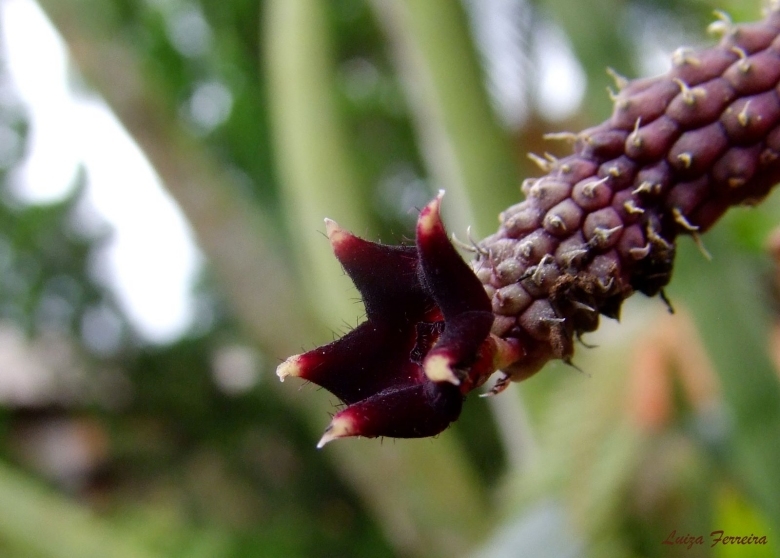Accepted Scientific Name: Echidnopsis sharpei subs. ciliata (P.R.O.Bally) Bruyns
Bradleya 6: 38 1988

Echidnopsis ciliata (Echidnopsis sharpei subs. ciliata) Photo by: Luiza Ferreira
Origin and Habitat: Echidnopsis sharpeiSN|30420]]SN|30420]] subs. ciliata is only known from the type locality, the upper “Sheikh” Pass, Somalia.
Altitude range: Around 1440 metres above sea level.
Habitat and ecology: This species growes together with a varied populations of succulents comprising Aloe somaliensisSN|30136]]SN|30136]] and Kleinia gunnisii.
Synonyms:
See all synonyms of Echidnopsis sharpei
Description: Echidnopsis sharpeiSN|30423]]SN|30420]] subs. ciliata (formerly Echidnopsis ciliataSN|30422]]SN|30425]]) is a perennial succulent with reclining, creeping, few-branched stems. Flowers appear singly or in twos, between the ribs, and are ca. 1 cm in diameter, with a short, bell-shaped tube and spreading corolla lobes that are uniformly deep purple on the upper side, with short papillae, and with cilia (hairs) on the margin.
Stems: Elongated, creeping or reclining, up to 20 cm long, 6–8 mm thick. Podaria slightly longer than broad, arranged in 8 ribs bearing the scars of the tiny, soon-falling blades in the upper part.
Leaves: Rudimentary to 1.2 mm long, stout, lanceolate-triangular.
Flowers: Flowers appear singly or in twos, between the ribs, on about 3 mm long pedicels. Corolla outside green, spotted with purple, inside densely hairy dark purple, 12-15 mm in diameter, tube broadly campanulate, not adpressed to side of staminal column. Corolla-lobes lobes triangular, 5-6 long, 5 mm broad. Corona, cup-shaped, pentagonal,with 5 rounded outer lobes, with dark purple-brown rim and white base. Inner corona-lobes broadly linear, basally white, reddish above, margins purplish-black. Outer corona-lobes reddish with rounded tips not reaching the centre of the staminal column.
Taxonomy: Bruyns (1988) reduced Echidnopsis ciliataSN|30420]]SN|30425]] to subspecific rank under Echidnopsis sharpeiSN|30425]]SN|30420]], but the two seem best treated as distinct species. Plowes (1993) separates Echidnopsis bavazzanoiSN|30425]]SN|30422]] and Echidnopsis lavranianaSN|30420]]SN|30423]] and ssp. ciliata is likewise treated as a species of its own.
Subspecies, varieties, forms and cultivars of plants belonging to the Echidnopsis sharpei group
 Echidnopsis sharpei A.C.White & B.Sloane: (subsp. sharpei) Pedicel 1 mm long. Corolla rotate, 6–10 mm wide dark red, sparsely hairy inside. Distribution: Somalia, Kenya and Ethiopia. 100–300 m.
Echidnopsis sharpei A.C.White & B.Sloane: (subsp. sharpei) Pedicel 1 mm long. Corolla rotate, 6–10 mm wide dark red, sparsely hairy inside. Distribution: Somalia, Kenya and Ethiopia. 100–300 m. Echidnopsis sharpei subs. ciliata (P.R.O.Bally) Bruyns: Pedicel 3 mm long. Corolla broadly campanulate, 12–15 mm wide dark purple, densely hairy on inner surface, tube broad, not adpressed to side of staminal column. Distribution: upper “Sheikh” Pass, Somalia 1440 m.
Echidnopsis sharpei subs. ciliata (P.R.O.Bally) Bruyns: Pedicel 3 mm long. Corolla broadly campanulate, 12–15 mm wide dark purple, densely hairy on inner surface, tube broad, not adpressed to side of staminal column. Distribution: upper “Sheikh” Pass, Somalia 1440 m.
Bibliography: Major references and further lectures
1) Focke Albers, Ulrich Meve “Illustrated Handbook of Succulent Plants: Asclepiadaceae: Asclepiadaceae” Volume 4 Springer Science & Business Media, 2002
2) M. Gilbert, D. Goyder, J. Lavranos, S. Liede-Schumann, M. Thulin, and J. Venter . “Flora Somalia”, Vol 3, (2006) [updated by M. Thulin 2008]
3) Werner Rauh “The Wonderful World of Succulents: Cultivation and Description of Selected Succulent Plants Other Than Cacti” Smithsonian Institution Press, 1984
4) Illustration: Bradleya 6: 25, 38 1988
5) Cact. Succ. J. Gr. Brit., 19: 59, top fig., 1957
6) James Cullen, Sabina G. Knees, H. Suzanne Cubey “The European Garden Flora Flowering Plants: A Manual for the Identification of Plants Cultivated in Europe, Both Out-of-Doors and Under Glass” Cambridge University Press, 11 August 2011
7) “Camel's Milk and Aloes: The travels of a Kew Expedition to Somalia by Margaret Johnson” in: The Cactus and Succulent Journal of Great Britain Volume 44(1): 9-16 (1982)
Cultivation and Propagation: Echidnopsis sharpeiSN|30420]]SN|30420]] subsp. ciliata is an easy obliging blooming plant, which is happy in any average succulent house. This plant is common to warrant any description, let it suffice to say that this plant is easy to grow and flower, and one which will tolerate most soils and growing conditions.
Soil: Since roots are quite shallow, use a cactus mix or add extra perlite or pumice to regular soil potting soil. A gritty, very free-draining compost is suitable, and clay pots help the plants to dry out between watering.
Watering: They require moderately watering through the growing season but enjoy plenty of water and some fertiliser in hot weather, this helps them to flower freely. Water more sparingly in winter according to temperatures. But, as with most asclepiads, it is unwise to leave them wet in cold weather.
Hardiness: Winter care presents no problems at 5-10°C with plenty of light.
Sun Exposure: Partial sun or light shade.
Pest and diseases: They are generally fairly easy to grow, especially if kept pest-free. They are susceptible to stem and root mealy bugs, and damage from these may well initiate fungal attack. If you do have problems with a stem or with basal rotting, you can reliably isolate the healthy parts, dry them off, and re-root them in moist compost.
Cultural Practices: Re-pot every 2 years.
Propagation: Easiest with stem cuttings. Allow cuttings to dry a day before planting. Stems must be laid (Not buried) on gritty compost and will then root from the underside of the stems. It can also be increased from seeds sowing in spring in moist, sandy peat moss. Barely cover seeds.










